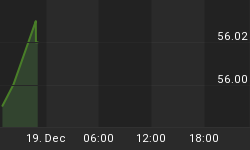While central banks continue to fret about the risks of disinflation and deflation due to expectations of slower growth, the numbers continue to suggest those concerns are misplaced. Yes, I know that inflation is supposed to lag growth, so that this year's recession is next year's disinflation, and I know that the S&P/Case-Shiller Home Price Index is also lagged due to its averaging structure. But the HPI is also exceeding economist expectations that ought to incorporate these facts. Consensus expectations were for the index to be flat on a year-on-year basis; instead, it rose 0.50% (June/June for the S&P/CS Composite-20) or 1.22% (Q2/Q2 for the broad US HPI) depending on your preferred flavor.
That news today, however, was blunted by the fact that Consumer Confidence posted its lowest reading of the year, fully 6 points below expectations at 60.6. The good news is that the subindex "Jobs Hard to Get," which is usefully correlated with the jobless rate, was essentially unchanged at 40.7 (see Chart, source Bloomberg), which is encouraging since the rise to this level augured the bump higher in the Unemployment Rate a few months back.

Incidentally, this is a great illustration of the fact that we are good at internalizing the actual condition of the employment situation. Respondents tend to say that jobs are getting harder to get before the Unemployment Rate actually rises. This is in sharp contradistinction to inflation, which we are very poor at internalizing. Survey responses about inflation tend to lag reported inflation, suggesting that respondents anchor on reported inflation; moreover, survey responses about inflation expectations also have an extremely high correlation to trailing inflation - which also suggests anchoring on the reported number, and by the way makes it hard to argue that "contained inflation expectations" might act as a meaningful brake on actual inflation. We just aren't good at evaluating the true inflation level, and our 'personal inflation heuristics' tend to be misleading because of cognitive biases (noticing rising prices more than falling prices, e.g.).
The weak Confidence number helped push bonds higher, but inflation-linked bonds rallied more than nominals, again. The 10-year inflation swap reached 2.59% today, up 0.26% in just over one month. Ten-year expectations are tracking gasoline prices to an unseemly degree (since 10-year gasoline prices are not moving nearly as much as spot gasoline prices!); retail unleaded gasoline is now over $3.75 and near the highest levels ever recorded for this date. This ought to affect 1-year inflation expectations, and it has: the 1-year inflation swap has risen 100bps since gasoline bottomed at the end of June. But the effect on the 10-year point is surprising, and suggests that investors believe the energy price rise isn't the usual (mean-reverting) type but driven by different underlying price dynamics.
Stocks were again near unchanged, and volumes again were punk. But we're yet another day closer to Jackson Hole, to the next Employment Report, to the next ECB meeting, and to the next Fed meeting. Speaking of the ECB, it raised eyebrows today when ECB President Draghi today canceled his trip to the Jackson Hole symposium, citing a 'heavy work load.' Poor, overworked Mario! Some investors took this to mean that the "heavy work load" involved imminent ECB actions, but I suspect that too much is being read into this. More likely, he is simply trying to avoid being lectured to about his monetary largesse - which has lifted year-on-year Eurozone money growth to a whopping 3.3%, the highest since 2009 - by policymakers who until recently were sporting M2 growth around 10%.
.
Yesterday, in talking about money velocity and the multiplier and so on, I alluded to an interesting relationship that I stumbled upon with respect to velocity. I'm not completely sure what to make of it. Here it is (chart source Bloomberg):

The yellow line above is M2 velocity. The white line is the S&P 500, divided by 10-year average nonfarm, nonfinancial corporate profits before tax (from Fed report F.102), which are easier to find on Bloomberg than S&P earnings. Because the earnings series covers earnings for a much wider swath of corporate America than is included in the S&P, this isn't an earnings multiple per se. It can fall because equity prices fall, or because earnings rise, or because the share of corporate earnings represented by the S&P declines. (This is the reason that the S&P appears much cheaper on this measure than if you use 10-year Shiller earnings on the S&P itself.) However, generally speaking this chart ought to trace the broad outlines of market valuation.
And this is very interesting. Prior to the first quarter of 1987...really dating right up to when Greenspan took office, plus or minus a few months...equity valuations varied inversely with changes in velocity. After that point, represented approximately by the vertical line, equity valuations varied directly with changes in velocity. In fact, the regime shift is shockingly abrupt, and shockingly clear. Almost every wiggle on the left of the chart is mirrored (the correlation of levels is -0.739); almost every wiggle on the right of the chart is echoed (the correlation is +0.745).
My friends, that's odd.
And I don't really know what to make of it, at the moment. What happened in 1987 to change this relationship? Was it one of these things?
- The stock market crashed.
- Alan Greenspan became Fed Chairman.
- The money multiplier peaked. Could the direction of change in the money multiplier have anything to do with the interaction of money velocity and asset prices?
What else? I am not presenting answers today, just more questions - and I am curious what readers may come up with.















